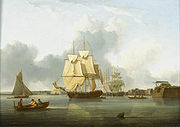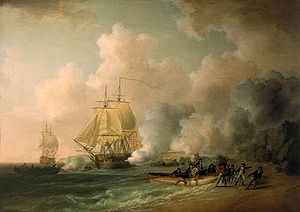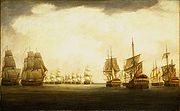.gif)
William Anderson (artist)
Encyclopedia


Anderson's training as a shipwright stood him in good stead when he became an artist specializing in maritime art based on the Dutch 17th century Masters. He first exhibited at the Royal Academy
Royal Academy
The Royal Academy of Arts is an art institution based in Burlington House on Piccadilly, London. The Royal Academy of Arts has a unique position in being an independent, privately funded institution led by eminent artists and architects whose purpose is to promote the creation, enjoyment and...
in 1780 and continued to exhibit annually until 1811. He then exhibited intermittently until 1834. His best work was executed in the years 1790–1810, during the French Revolutionary
French Revolutionary Wars
The French Revolutionary Wars were a series of major conflicts, from 1792 until 1802, fought between the French Revolutionary government and several European states...
and Napoleonic Wars
Napoleonic Wars
The Napoleonic Wars were a series of wars declared against Napoleon's French Empire by opposing coalitions that ran from 1803 to 1815. As a continuation of the wars sparked by the French Revolution of 1789, they revolutionised European armies and played out on an unprecedented scale, mainly due to...
, at which time the demand for naval paintings was high. He painting was not restricted to marine subjects.
His pictures, shown at exhibitions, include A View of Berwick-on-Tweed and A View of Tynemouth. His history paintings include The Battle of Waterloo, The Capture of Fort Louis, Martinique, 1794, which shows the attack by Commander Robert Faulknor
Robert Faulknor the younger
Robert Faulknor the younger was an 18th century Royal Navy officer, part of the Faulknor naval dynasty. He was court-martialled and died in an action off Guadeloupe in the eastern Caribbean Sea.-Early life:...
of on Fort Saint Louis (Martinique)
Fort Saint Louis (Martinique)
Fort Saint Louis is a fortress on a peninsula at Fort-de-France, Martinique. Today the Fort is both a naval base and an Historic Monument. There are daily tours of the fort, though the portion that is still a naval base is off-limits.-Naval Base:...
, The Battle of Cape Finisterre, The First Battle of Groix and The Battle of the Nile . Other paintings include Shipping on the Thames at Deptford and View at the mouth of the Thames ..

John Ward (painter)
John Ward was a British painter.Born and worked in Kingston upon Hull. Friend of artist William Anderson.-References:...
(1798–1849), whom he influenced. He also was a friend of the painter Julius Caesar Ibbetson
Julius Caesar Ibbetson
Julius Caesar Ibbetson was a British 18th-century landscape and watercolour painter.-Early life and education:...
, (1759–1817).
Anderson and his wife Sarah had two sons, William and George. Anderson's son, William Guido Anderson, served in the Royal Navy
Royal Navy
The Royal Navy is the naval warfare service branch of the British Armed Forces. Founded in the 16th century, it is the oldest service branch and is known as the Senior Service...
and was fatally wounded at the Battle of Copenhagen in 1801, as a midshipman
Midshipman
A midshipman is an officer cadet, or a commissioned officer of the lowest rank, in the Royal Navy, United States Navy, and many Commonwealth navies. Commonwealth countries which use the rank include Australia, New Zealand, South Africa, India, Pakistan, Singapore, Sri Lanka and Kenya...
on HMS Bellona
HMS Bellona (1760)
HMS Bellona was a 74-gun Bellona-class third-rate ship of the line of the Royal Navy. Designed by Sir Thomas Slade, she was a prototype for the iconic 74-gun ships of the latter part of the 18th century...
. His son, George Anderson. was also a painter.

